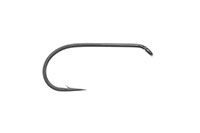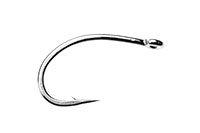
Mountain Streams --Vol.10--
The Birth of Crazy Badger
When I was wandering around various water source areas to fish char, I was often surprised at the mysterious power of peacock. I also began to feel special significance of white colour. Strictly speaking, I got the distinct impression on white dry flies because I exclusively used dry flies in those days.
Spent Badger. Fish jump at it like mad. At first it was named Crazy Badger for this reason.

The first waterfall of Mariko creek. The creek became very steep and dark past here.
The first flies I learned, besides Royal Coachman, are as follows.
- Black Gnat
- Scarlet Ibis
- Yellow Sally
- Professor
- Parmachene Belle
- Adams
- Pink Lady
- Light Cahill
- Brown Bivisible
- Mosquito
- White Miller
There were 12 patterns including Royal Coachman. I had three of each, so there were 36 in total. All the flies I could easily got in 1970 were this kind of fly set that was made for export to U.S.A. It was not until I tied those patterns by myself that I found those flies I had carefully kept were not tied properly or designed properly, either. In those days I had no doubt about my precious flies.
Now I am going to talk about a white fly, White Miller. Frankly speaking, I have more things to talk about Parmachene Belle, but in those days the latter was too difficult for me to tie. Therefore, I learned about white colour exclusively from White Miller.

Natural yamame trout living only in creeks are very beautiful beyond description.
Good-bye to White Miller
In my early days of fly fishing the biggest and most serious problem was that I could not see my fly. That was caused partly because my fly was not floating and partly because I could not find the whereabouts of my fly. I needed more time to realize that I did not have to look for the fly but I should drift it where I was watching. In those days I had no confidence in dealing with dry flies, but White Miller was the most reliable fly because of its white colour. I could see it well. Even when it sank into the water, I could keep my eye on it as far as it stayed near. Furthermore, in the evening when it is getting dark, the paramount hours for anglers, no other fly is more visible than white ones. In this situation, White Miller was more reliable for me than Royal Coachman. When I got a new dry fly set of 3 dozen flies I mentioned above, I used up all White Millers first, while Adams and Mosquitoes, which were not clearly seen, were left unused and moved into a next box.However, as I got accustomed to keeping my eye on the fly, I had less opportunity to choose White Miller. One of the big reasons was that other flies became available to me and another was that I felt somehow that fish would not take White Miller well. But I seldom felt that fish did not come up well to it. I pondered why and finally guessed that there was something that stopped fish from taking it in its mouth after they came up to it.

A tiny pond of 10 square metres is a big spot in this creek. Several yamame trout jump at the fly.
One day of May I could not wait to fish the upper reach of the creek I had found a few days before. I went alone to Okutama in the suburbs of Tokyo in the season of new green leaves. The creek was a tributary of the Tama River that flowed through the mountain behind Taba Village. It was named Mariko creek. A few days before it had been raining and I could fish only near the entrance of creek. It was a small creek but I had caught a nice sized yamame trout, so I could not wait to fish the upper reach of the creek.
On that day it was cloudy and humid, very suitable for fishing in mountain streams. After I passed the last pool from where I had turned back a few days before, the creek flowed calmly through the copse for a while. Although the water surface was covered with hanging branches, I managed to cast my fly to see beautiful patterned yamame trout jump at it at almost every point. I knew that I took the right rod of 6 ft. with me. After I passed through the copse, a waterfall suddenly appeared in front of me. I fished another several yamame trout in its basin. Looking around carefully, I found the faint tracks on the left surface of the mountain. I climbed carefully along the waterfall, grabbing the grass roots. The scenery changed dramatically above the waterfall. Both banks were so near to each other that I could hardly see the sky and steep rocks stretched away. Fish often jumped at the notable points but it was too dark to see the fly clearly even in the daytime. I changed the fly from Royal Coachman to White Miller, put it to the leader and walked further upstream.

A natural yamame trout of 25 cm can be said rather big.

After I fished through the dark middle reaches of the creek, there suddenly spread bright water source area.
More steep rocks soared upstream. Water was low enough that there was no risk being washed away but it would be still very dangerous if I had missed my step. My new fly was clearly seen in that dark creek. But gradually the fish did not respond well and I began to give up fishing. As I turned a steep curve of the creek, my field of vision suddenly opened up. I could see the large sky in front and the mountain ridges to both right and left side. The creek became less steep and there appeared some gently flowing points. There were increasing number of fish, too. As I drifted the fly in a small pool, five or six yamame trout jumped at it. In the next pool, many fish jumped at the fly again. But only a few of them took my fly. I changed the fly from White Miller to Royal Coachman. Then there was a dramatic change. The fish jumped at the fly a little more slowly but they took it in its mouth firmly. So it was easier to set the hook to the fish and the hook caught the jaws of fish more firmly. It was very easy fishing.
That was only one day's experience but gave me a good answer to my question I could not solve for long time. It was clear that fish responded more nervous to White Miller than to other flies, so White Miller had less chance of hooking. After that I had less opportunity to put it to the leader except for using it as the most clearly visible fly in the dark.
-- To be continued --
- NET SHOP INFORMATION

SL6 Black Spey Hooks

DU3 Limerick Spinner Hooks

SL4 Single Bartleet Hooks

XD1 Tube Fly Double Hooks

DD2 Flat Perfect Hooks

DD1 Black Terrestrial Hooks

TD4 Old Limerick Wet Hooks

DU1 Silver May Hooks

MU1 Flat Midge Hooks

LD3 Long Limerick Hooks

TD2 Summer Sproat Hooks

XS1 Tube Single Silver Hooks

TD6 Siver Sedge Hooks

SL5 Black Spey Hooks

DU3 Limerick Spinner Hooks
- TROPHY CLUB
- FLY SHOW
- EXHIBITION
- MASTERS`
- FLY DRESSING CONTEST Archives
- TRAVELLER Archives
- TACKLE IMPRESSIONS Archives
- ANGLERS` PHOTO GALLERY Archives
- ----------------------------------------------
- トロフィークラブ
- フライショー
- エキシビション
- マスターズ
- フライドレッシング・コンテスト・アーカイヴ
- トラヴェラー・アーカイヴ
- タックル・インプレッション・アーカイヴ
- アングラーズ・フォトギャラリー・アーカイヴ
株式会社サワダ 185-0021 東京都国分寺市南町3-13-4
SAWADA'S INC. 3-13-4 Minamicho, Kokubunji, Tokyo 185-0021, Japan
写真・ドキュメントの無断転載を禁じます。
All the images and documents found on this site are owned by Ken Sawada and may not be used without permission.
But, link to this site is FREE.
Copyright © 2000 - 2024 SAWADA'S INC.. All rights reserved.
SAWADA'S INC. 3-13-4 Minamicho, Kokubunji, Tokyo 185-0021, Japan
写真・ドキュメントの無断転載を禁じます。
All the images and documents found on this site are owned by Ken Sawada and may not be used without permission.
But, link to this site is FREE.
Copyright © 2000 - 2024 SAWADA'S INC.. All rights reserved.
